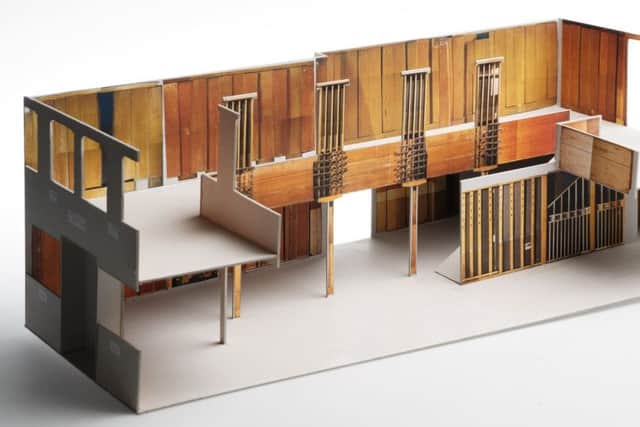V&A to recreate lost Charles Rennie Mackintosh work


Hundreds of surviving pieces of a Mackintosh-designed tearoom are to be reassembled to become a centrepiece attraction at the new V&A in Dundee.
It will give the public the chance to see the only surviving set of Mackintosh tearoom interiors for the first time in more than half a century – thanks to vital salvage work before it was knocked down.
Advertisement
Hide AdThe Heritage Lottery Fund is providing £400,000 to allow part of Miss Cranston’s tearoom, on Glasgow’s Ingram Street, to be conserved, restored and reassembled in the new £80 million attraction, which is due to open in 2018, the 150th anniversary of the celebrated architect’s birth.


It was one of four establishments opened by the ground-breaking tearoom entrepreneur Catherine Cranston, one of Mackintosh’s biggest supporters.
He originally created several murals for the Ingram Street tearoom, which opened in 1896, and was then asked to completely redesign its interior between 1900 and 1912.
The premises remained in use as a tearoom until 1951 when it was taken over by the then Glasgow Corporation and turned into shops and storage spaces.
However, before the building was demolished in 1971 to make way for a new Stakis hotel, the local authority dismantled, documented and removed all the interiors, with each piece of wall and panelling individually recorded.


The 45ft-long recreation of the “Oak Room” from the tearoom will have pride of place in the Scottish design galleries being created at the new V&A.
Advertisement
Hide AdLittle photographic evidence of the tearoom is known to exist and only a very small part of the room’s interior has ever been on display again since it closed, at Kelvingrove gallery.
The project to breathe new life into the tearoom has been more than two years in the planning, involving the V&A Dundee team and staff at Glasgow Museums.
Advertisement
Hide AdThey have spent more than two decades conserving and recording the surviving elements.
Philip Long, director of V&A Dundee, said: “When we set about planning the Scottish design galleries for V&A Dundee, it was vital that Mackintosh, recognised around the world as one of the great and most influential of designers, was represented appropriately.
“The recreation of the tearoom will be the most significant representation of Mackintosh in V&A Dundee.
“Part of the Oak Room’s significance is that Mackintosh would have designed it around the time he was designing the library at Glasgow School of Art.”
Joanna Norman, lead curator for the Scottish design galleries, said: “This will be the only historic interior on display in the two galleries, which will give a broad chronological sweep of Scotland’s design story.
“We will have around 250 objects going on semi-permanent display in these galleries, which will take up around half the overall display space in the museum. The reassembly of the Oak Room will allow visitors to immerse themselves fully in the brilliance of Mackintosh’s spatial and decorative design, which he had a reputation for across Europe when he was working.”
Advertisement
Hide AdColin McLean, head of the Heritage Lottery Fund in Scotland, which is supporting the new museum to the tune of £14 million, said: “Charles Rennie Mackintosh and his distinctive designs are admired around the globe.”
Tea tycoon was architect’s biggest patron
CATHERINE Cranston, the daughter of a pastry maker-turned-hotelier, helped transform Glasgow’s dining scene with the tearooms she introduced to the city at the end of the 19th century.
Advertisement
Hide AdStarting with the Crown Luncheon Room, on Argyle Street, in 1878, she immediately set high standards for service, food quality, ambience and friendliness.
Her Ingram Street tearoom opened in 1886 and was followed by new premises on Buchanan Street in 1897 and Argyle Street in 1898.
Experts say Mackintosh’s stylistic development between 1896 and 1911 can be charted through the evolution of his designs for her.
Alison Brown, curator of European decorative art at Glasgow Museums, said: “She was probably the biggest patron of Mackintosh and she was also one of the few female entrepeneurs in the city at the time.
“She was using marketing and branding way before it became fashionable to do so.”